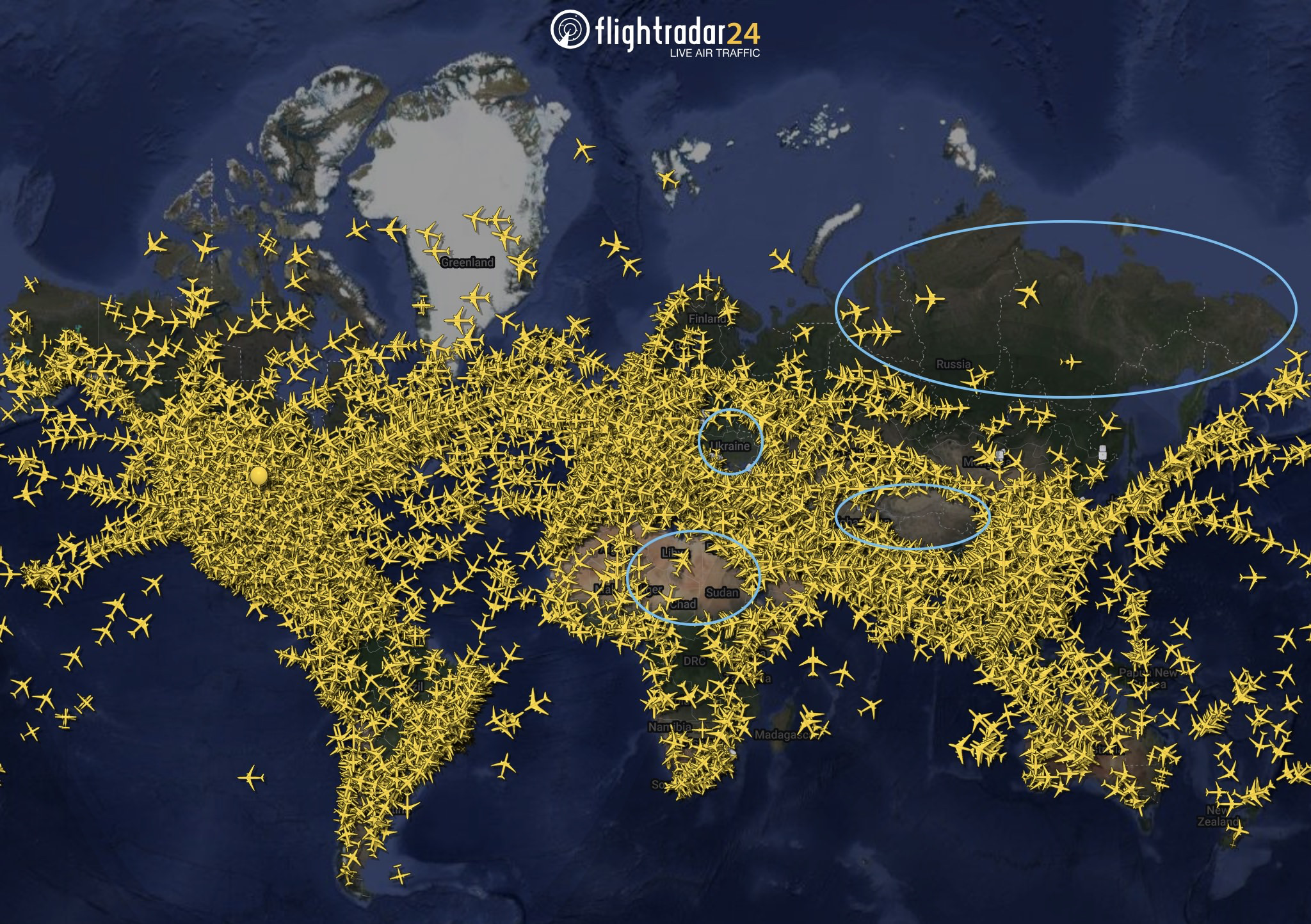Unsettling Flight Map Reveals Skull-Like Formation, Sparking Anxiety Among Viewers
On June 17, 2025, FlightRadar24, a widely recognized flight tracking platform, shared a strikingly eerie map that caught the attention of aviation enthusiasts and casual observers alike. The map displayed a peculiar formation that closely resembled a human skull, igniting conversations and concerns across social media. This unsettling pattern emerged from four significant gaps in global air travel, which unintentionally combined to create a skull-like image. These gaps, located over Ukraine, Iran, Tibet, and Central Africa, led many viewers to describe the visual as “death staring back from the world map.”

As the image rapidly gained traction online, FlightRadar24 seized the moment to clarify the reasons behind these significant aviation no-fly zones. The peculiar skull formation serves as a stark reminder of the regions where airlines exercise extreme caution or outright avoidance due to ongoing conflicts, safety concerns, and geographic challenges. This incident illuminated a critical aspect of global air traffic and the complexities that underlie flight operations, prompting an important dialogue among the public and industry professionals alike.

The Skull Pattern: A Closer Look at Regional Gaps
The regions contributing to this unsettling pattern are not arbitrary; they are fraught with implications for air travel safety and operational logistics. The eye sockets of the skull shape are represented by gaps over Eastern Europe and East Asia, while the nose bridge is formed by the void over the Middle East, and Central Africa outlines the mouth. Collectively, these dead zones encapsulate millions of square miles where commercial airlines are generally prohibited from flying.
The absence of flight routes over Ukraine, for instance, is a direct consequence of the ongoing conflict that has engulfed the region, particularly since 2022. The war has severely disrupted normal air traffic, forcing airlines to adjust their flight paths and implement safety measures that include avoiding the airspace altogether. In fact, many airlines have opted to reroute their flights to avoid Ukrainian airspace entirely, often adding significant distance and consequently higher costs for passengers. Conversely, the lack of air traffic over Tibet can be attributed more to geographical challenges than to political instability. The region, which boasts an average elevation of around 14,800 feet, is notorious for its severe air turbulence, unpredictable weather conditions, and limited emergency landing spots.
The Geographical Challenges of Tibet
Tibet presents unique challenges for aviators that are largely unrivaled elsewhere in the world. When cabin pressure drops and pilots are required to make a rapid descent, they typically aim to reach an altitude of 10,000 feet or lower for passenger safety. However, much of Tibet’s terrain remains above that threshold, creating a perilous situation where pilots risk colliding with mountain peaks if they attempt to descend quickly. Moreover, the region’s frequent storms and high winds can lead to dangerous flying conditions. Given these factors, many airlines find it more prudent to reroute flights far from the region, even if this means extending travel time and increasing operational costs.
The Broader Implications for Global Airlines
The spotlight on this unsettling flight map has broader implications for the aviation industry. The pattern of avoiding certain regions due to conflicts or topographical challenges reflects a complex web of geopolitical and environmental factors that airlines must navigate. The financial burden is substantial; airlines face increased operational costs when they opt to operate in areas deemed unsafe or unstable, which not only affects profitability but also places a premium on passenger safety. Consequently, travelers may find that ticket prices soar as airlines compensate for the increased risk associated with flying over contentious areas.
Furthermore, the rising tensions in some regions of the world have prompted airlines to rethink their strategies when planning routes. This cautious approach can lead to higher operational costs, a smaller number of flights available for passengers, and the potential for longer wait times. Passengers may not only experience delays but may also find that their itineraries are altered unexpectedly, adding another layer of complexity and frustration to air travel.
Public Reaction and Perception
The viral nature of the skull-shaped flight map has sparked varied reactions from the public. While many found the image unsettling, others viewed it as a fascinating representation of the complexities of global air travel. Social media platforms were flooded with comments ranging from shock and disbelief to insightful discussions about the implications of such flight patterns. Some users expressed concern over the safety of air traffic in general, while others highlighted the importance of understanding geopolitical dynamics that influence airline operations. For example, several analysts noted that the pattern serves as a visual warning of how global instability can directly impact civilian air travel, raising important questions about the future of aviation.
As discussions continue, it is crucial to understand that these gaps in air traffic are not merely visual anomalies but rather significant indicators of ongoing global issues. They illustrate the delicate balance between safety, politics, and the operational strategies that airlines must employ to protect their passengers and ensure successful travel. This underscores the need for ongoing dialogue among policymakers, airlines, and the public to foster a more secure and efficient aviation environment.
Conclusion: Understanding the Unseen Forces in Aviation
The skull-like pattern on the flight map shared by FlightRadar24 serves as an alarming visual metaphor for the current state of global air traffic. It underscores the unsettling reality that safety concerns, geopolitical conflicts, and challenging geographic features continue to shape our skies. As travelers, it is essential to remain informed about the factors that influence flight availability and safety. Airlines and passengers alike must navigate these complexities, ensuring that air travel remains a safe and reliable means of transportation. By fostering awareness and understanding, we can work together toward a future where flying is as safe and accessible as possible, regardless of the challenges that may arise.

















